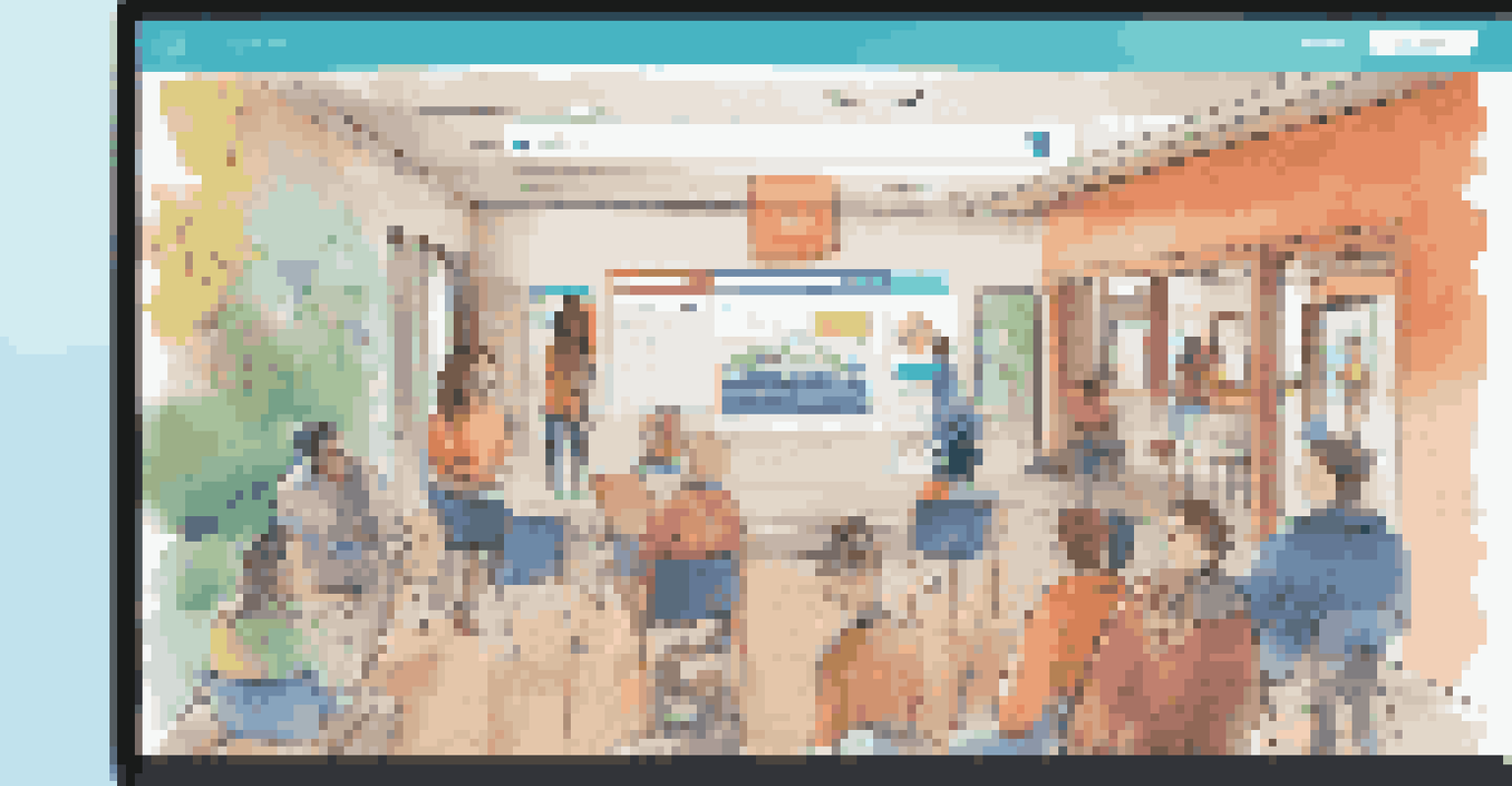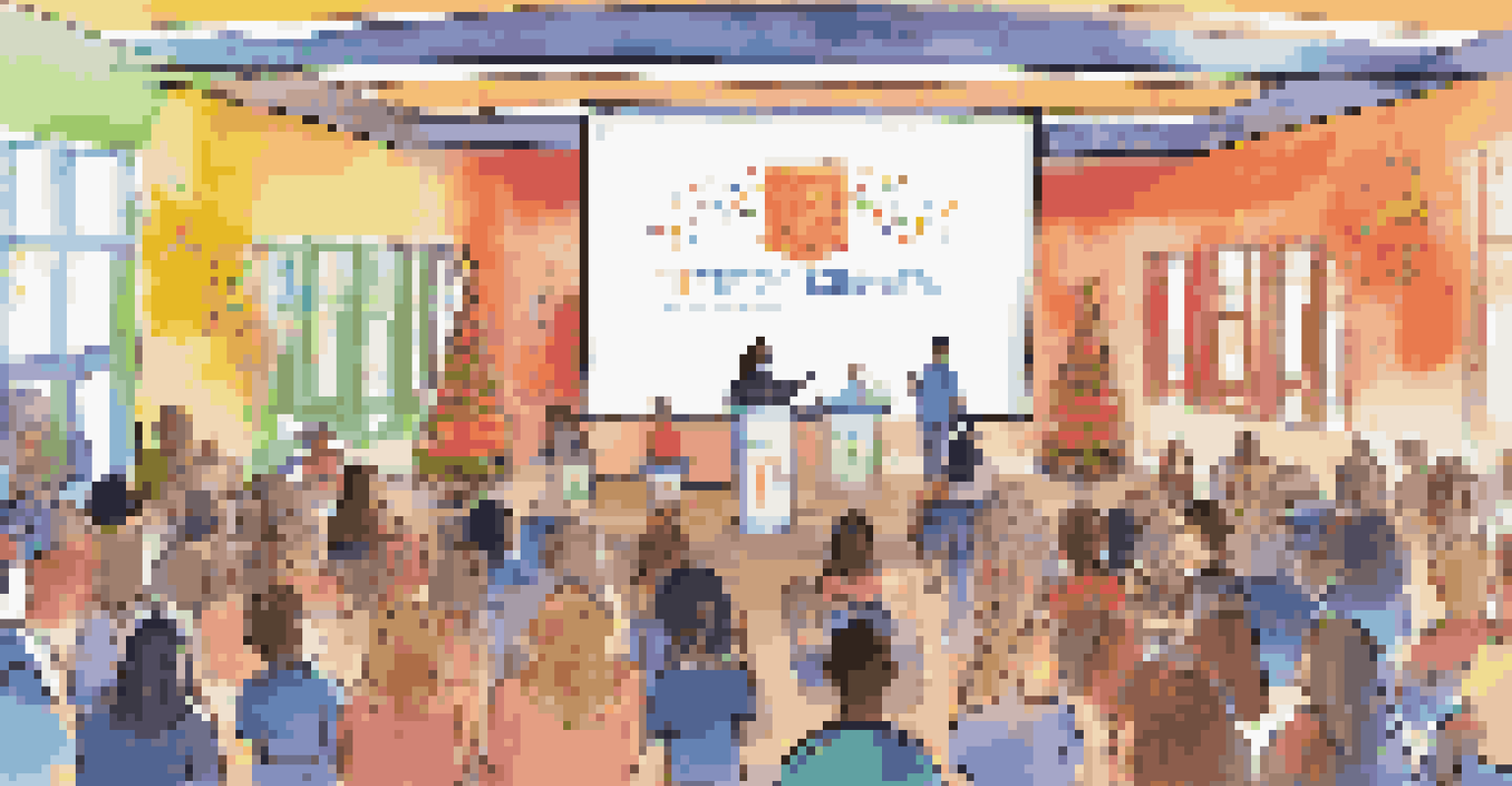Building Community Engagement in Blended Learning Settings

Understanding Blended Learning and Its Importance
Blended learning combines traditional face-to-face instruction with online activities, creating a flexible learning environment. This approach allows learners to engage with content at their own pace while still benefiting from direct interaction with instructors and peers. Understanding this blend is crucial as it sets the foundation for community engagement, which enhances the overall learning experience.
Blended learning is not just a trend; it’s a transformative approach that enhances the educational experience by combining the best of both worlds.
By fostering a community within blended learning, educators can create an atmosphere of collaboration and support. It encourages students to share their thoughts and questions, making the learning process more interactive. When students feel connected to their peers and instructors, they are more likely to participate actively and take ownership of their learning.
Moreover, community engagement in this setting can lead to improved academic performance and higher retention rates. When learners feel part of a supportive community, they are less likely to disengage or feel isolated. Therefore, recognizing the importance of community in blended learning is the first step toward effective engagement strategies.
Creating a Welcoming Online Environment
A welcoming online environment is essential for fostering community engagement. This can be achieved by designing user-friendly platforms that are easy to navigate. When students feel comfortable using the technology, they are more likely to participate and engage with their peers.

Incorporating icebreaker activities at the beginning of a course can also help establish connections among students. These activities encourage learners to share personal experiences and interests, creating a sense of camaraderie. A simple introduction can break down barriers and pave the way for more meaningful interactions throughout the course.
Blended Learning Enhances Engagement
Combining traditional and online learning fosters community, leading to improved academic performance and retention.
Additionally, using visuals such as videos and images can make the online space feel more inviting. When students see vibrant and dynamic content, it can spark interest and motivate them to engage more actively. A warm, engaging online environment is key to building a strong sense of community.
Encouraging Collaboration Through Group Activities
Group activities are a powerful tool for building community in blended learning settings. By working together on projects, students can share ideas and support one another’s learning processes. This collaboration not only enhances their understanding of the subject matter but also fosters deeper relationships among peers.
Collaboration allows us to know more than we are capable of knowing by ourselves.
Utilizing online platforms for group discussions and collaborative projects can help maintain engagement. Tools like discussion boards or shared documents allow students to contribute at their convenience, accommodating different schedules. The key is to ensure that every group member feels their input is valued and essential to the project’s success.
Moreover, these collaborative experiences can lead to the development of critical skills, such as teamwork and communication. When students learn to work together effectively, they prepare themselves for similar interactions in the professional world. Thus, group activities serve as both an educational and community-building experience.
Fostering Open Communication Channels
Open communication is vital for building community engagement in blended learning. Establishing clear channels, such as forums, chat rooms, or virtual office hours, encourages students to reach out and share their thoughts. When learners know they have the opportunity to communicate freely, it creates a sense of belonging.
Regular check-ins and feedback sessions can also enhance communication. By actively soliciting student input on course materials and teaching methods, instructors demonstrate that they value student perspectives. This two-way communication builds trust and reinforces the idea that the learning experience is a shared journey.
Creating Connections is Key
Establishing a welcoming online environment and encouraging collaboration through group activities helps build strong relationships among learners.
Creating a culture of openness ensures that students feel safe expressing their concerns and challenges. When they know their voices are heard, they are more likely to engage and participate actively in the learning community. Therefore, fostering communication is crucial for enhancing overall engagement.
Leveraging Technology to Enhance Engagement
Technology plays a significant role in enhancing community engagement in blended learning. Utilizing various tools, such as video conferencing and interactive platforms, can create more dynamic learning experiences. These technologies allow for real-time interactions and help bridge the gap between online and in-person learning.
Implementing gamification elements, such as quizzes or challenges, can also boost engagement. When students participate in game-like activities, they are more likely to enjoy the learning process and feel motivated to connect with others. This approach adds an element of fun while facilitating community interactions.
Furthermore, using social media groups can facilitate ongoing discussions outside of formal learning environments. These platforms provide informal spaces for students to connect, share resources, and collaborate. Leveraging technology effectively helps to create a vibrant, engaging community.
Building Relationships Through Personalized Learning
Personalized learning is a key strategy for enhancing community engagement in blended settings. By tailoring experiences to meet individual student needs, educators can foster a deeper connection with their learners. When students feel that their unique learning styles and preferences are acknowledged, they are more likely to engage actively.
Regularly checking in with students to discuss their progress and challenges can also strengthen these relationships. By offering personalized feedback and support, instructors demonstrate their commitment to each student's success. This individualized approach not only builds trust but also encourages students to seek help and collaborate with peers.
Regular Feedback Fuels Improvement
Evaluating and adapting engagement strategies based on student feedback ensures a responsive and dynamic learning community.
Ultimately, fostering personal relationships within the learning community creates a supportive environment where students thrive. When learners feel valued and understood, they are more likely to contribute positively to the community. Thus, personalized learning is integral to building strong connections.
Celebrating Achievements and Milestones Together
Celebrating achievements, both big and small, is essential for nurturing community engagement. Acknowledging student successes creates a positive atmosphere and reinforces the value of collaboration. Whether it’s completing a project or achieving a personal learning goal, celebrating milestones fosters a sense of belonging.
Incorporating recognition ceremonies, shout-outs in class, or even digital badges can motivate students to strive for excellence. When students see their efforts recognized, it encourages them to continue engaging with their peers and the learning process. This recognition creates a cycle of encouragement that strengthens community bonds.

Moreover, celebrating collective achievements, such as successful group projects, reinforces teamwork and collaboration. It reminds students that they are part of a larger community working towards common goals. By celebrating together, the community becomes more cohesive and supportive.
Evaluating and Adapting Engagement Strategies Regularly
Regular evaluation of engagement strategies is crucial for maintaining a vibrant learning community. Feedback from students can provide valuable insights into what works and what needs improvement. By being open to change, educators can continuously adapt their approaches to better meet the needs of their learners.
Conducting surveys or focus groups can help gather information on student experiences and preferences. This data allows instructors to identify areas for growth and develop more effective engagement strategies. Regular assessment ensures that the community remains responsive and dynamic.
Additionally, sharing these evaluation results with students fosters transparency and trust. When learners see that their feedback leads to tangible changes, they feel empowered and valued. This collaborative approach reinforces the sense of community and commitment to collective success.